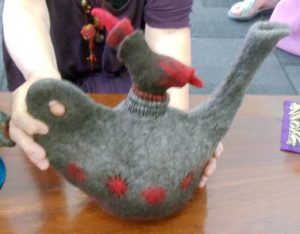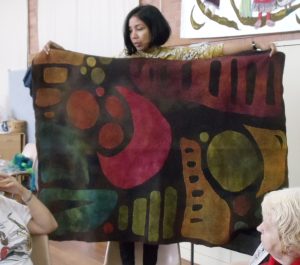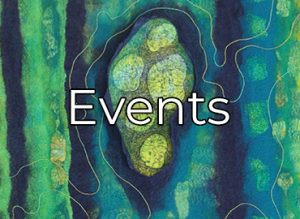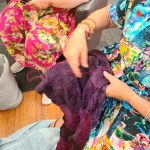September 2017 Toss ‘n’ Tell
Demonstration – Silk Paper -Nancy Ballesteros
Please see full instructions on Nancy’s website here: http://treetopscolours.com.au/more/make/silk-paper/
Materials & utensils:
Bombyx or tussah silk tops, baking paper, iron, ironing board, starch (either spray or powder & water mixed in spray bottle), water, net, textile medium or acrylic gloss medium/varnish, anti-static spray (if required).
Bombyx silk tops are made from silkworms fed exclusively on mulberry leaves. It contains no tannin and has a higher lustre. You may need to ‘snap’ your bombyx fibre to unstiffen it. It stiffens in response to being wet in the dyeing process.
Tussah silk tops are made from ‘wild’ silkworms, that are not cultivated and eat a variety of foods. It contains tannin as a result. Either type of silk tops can be used to make silk paper, depending on the effect you require. You could also try throwsters waste or flax fibres.
Different bonding materials have different pluses and minuses. They are available as stores such as Jacksons Drawing Supplies, Oxlades etc. Various media can be watered down to as little as 10% concentration. Some give a cloudier result than others. Atelier brand gave a nice finish without ruining the lustre of the silk. Some brands available are Atelier & Jo Sonja.
- Textile medium should not be watered down, and needs to be heat set. It gives a nicely flexible result.
- Ceracin (obtained from silk, the natural bonding agent used by silkworms) is not viable as a bonding agent due to its enormous cost – $1000 per ml!!! (It is in high demand by the cosmetics industry.)
- PVA works as a bonding agent, but does not cope with humidity as it is a water based product.
- Starch is available as a pre-mixed spray (eg Fabulon) or the old-fashioned powder type that you mix with water & put into a spray bottle for ease of use. This is still available at IGA. Nancy believes that powder starch rinses out better than pre-mixed spray starch, and has a less offensive smell.
Instructions:
Pull and lay silk out as you would with laying out wool fibre for felting. Some people have problems with static at this stage. If so, you may purchase anti-static spray from the supermarket in the laundry section. Fibres must be laid in at least 2 or 3 directions to provide sufficient strength in the paper.
If using acrylic gloss medium, the silk needs to be wet down with soapy water before applying the medium, otherwise the medium will not penetrate the fibres. It is advisable to lay the fibres down on net to prevent bonding at this stage. Media that don’t need to be heat set can be dried on something like a fly screen, so that it doesn’t bond to the fabric net. Media that need to be heat set can be ironed between 2 sheets of baking paper. Don’t use steam, as you are aiming to dry it out. If the silk paper doesn’t peel easily off the baking paper, you need to iron it more to remove the moisture.
If the layers are not bonding apply more starch and continue ironing. Alternatively, you could try starching between the layers as you lay the fibres down. Re-do if necessary.
If you choose you could lay the fibres down in a random rather than directional pattern for a different effect.
Once you have made silk paper you can cut a very precise shape from it and apply it to your felt. Silk paper for felting needs to be semi see-through, so that it can be grabbed by the wool. If it is too thick the wool fibres won’t grab it. If it is too fine, it will be swallowed up by the wool and disappear into the felt rather than sitting on top. Silk paper can be quilted or embroidered on the surface.
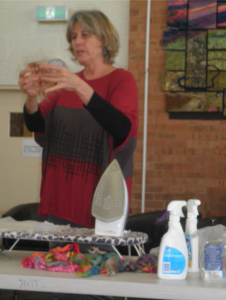
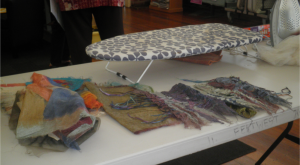
Nancy gave an interesting demonstration that engaged the audience, and prompted many questions. She did stress that there is quite an element of trial and error involved in this process, depending on your purpose and what kind of result you wish to achieve. Keep experimenting!
Toss ‘n’ Tell
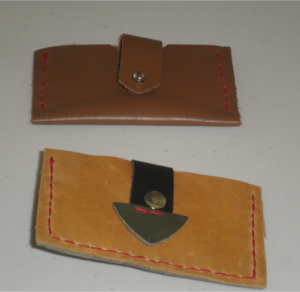
We had a few showings of pieces worked at the recent Leather Workshop run by Bec Fogarty of Hammered Leatherwork. All participates made credit card holder to learn how to use the tools.
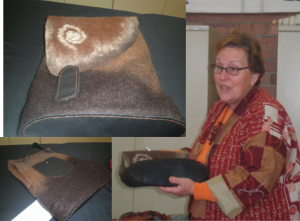
Marion Finneron – Marion has made a felt bag with a magnetic catch, leather strap & base, and a leather pocket on the back.
Christiane Gray – felt and leather bag in red and green tones. Christine stitched her bag by hand.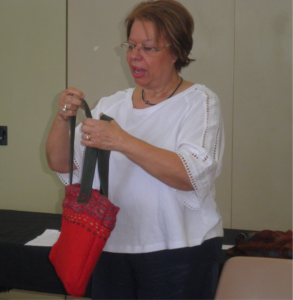

Alison Gomes – Felt and leather crossbody bag.

Jill Jodrell – produced a number of small items at the Leather Workshop: a card holder, sunglasses case and a belt pocket.
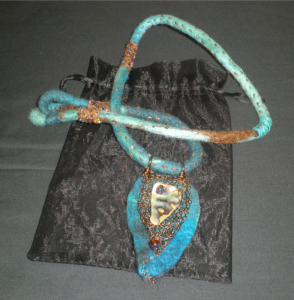
Christine also made a felt necklace as thank you gift for the upcoming workshop.

Nancy’s nuno felted shawl “Wandering in Purnululu” felted onto both silk mesh and tissue silk in beautiful ‘outback’ colours. Fibonacci stripes were used in the design of the garment, and some stitching was done post felting for embellishment. The shawl was made for an exhibition called “Dare to Wear” which was stages in Williams and various other towns in Western Australia.
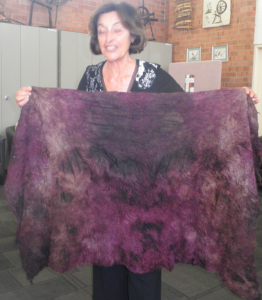
Teresa Rocchi – produced a piece of felted fabric at Sue Swain’s workshop. Teresa has a dressmaking background, and intends to use the fabric to make a skirt.
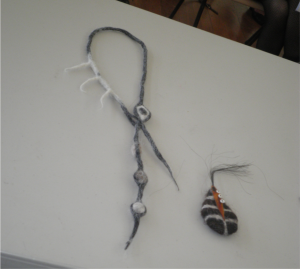
Katrina Virgona – produced an IPad pouch and a small purse of leather and felt made from a fulled jumper (sorry no picture). Katrina showed a few pieces from a recent exhibition at Mundaring Arts Centre “The Habits of Horses”. This consisted of a neckpiece and other small pieces using felt and horsehair.
Sue Swain’s 3 gorgoeus garments.
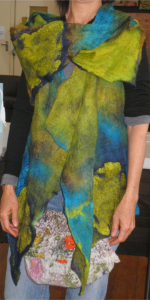 Wearable felt wrap made for a
Wearable felt wrap made for a 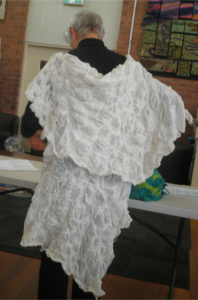 friend. (Picture not shown) It consisted of two oval layers that overlap.
friend. (Picture not shown) It consisted of two oval layers that overlap.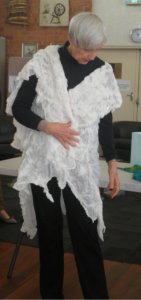
A wrap that was too long for requirements. Sue cut some fabric off the length, and used this to make a collar that lies over the top of the garment.
A long cream wrap with arm holes. The garment is in one piece, the top edge flips over to form a collar. Sue found that the upstanding seams were too heavy, so trimmed them off.
Jacquie- a returning past member introduced herself to the group.
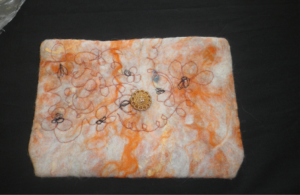
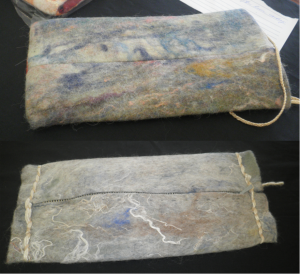
Judith Shaw – showed a number of pieces that she produced after drum carding the wool. Leftover scraps of wool in different colours were mixed in an unplanned way. She also added pieces of white flax which combined beautifully with the wool for an interesting effect. One of the items made was a pencil case.
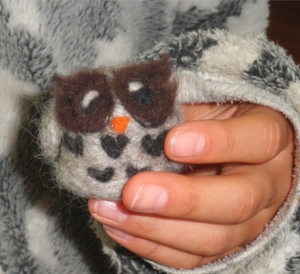
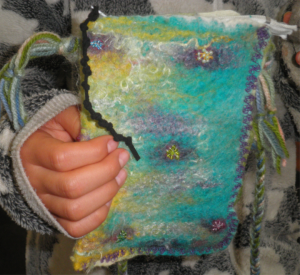
Our young 11 year old showed a beautifully detailed small needle felted owl & a felted pouch style bag. The pouch was embellished with beading and machine stitching. Well done!

Liz Owens’ felted hat with little spring sticking out the top. The hat was tall to start with, but folded down almost like a pleated effect, to become something like the shape of a fez.
Toss ‘n’ Tell News
Chair: Karen Woods.
Craft House, Menora.
Reminders :
- Leiko Uchiyama’s artist talk coming up on Friday 6 October 2017, 7pm to 8.30pm. Craft House Main Hall. Light refreshment available. Those who can please bring a plate.
- Bookings are now open for Martien van Zuilen’s ‘Jigsaw Weave and Felt’ workshop to be held on November 4-5.
Questions raised:
- To the membership regarding the membership contact list. Do members wish to have it available electronically or in hard copy? Members present decided that names and emails were sufficient. It was agreed by the membership that a member may have their details suppressed if they wish it. Some members were happy with an electronic document, others wished to be provided with a hard copy.
- Feltwest Facebook page and website: Are members happy to have photographs of work displayed on the Facebook page? Are they happy to have names with the work or not? Are they happy to have members photographed ad displayed with their work?Nancy Ballesteros stated that currently the website is used to provide information to members regarding other activities and organisations that our members may be interested in. Concerns were raised regarding privacy, and the possibility of the public copying members ideas/work. It was decided at the meeting to leave it as it is currently.
- If members wish to have items posted on the Facebook page they can send it to one of the Facebook administrators via a message on “Contact us”. Current administrators are Soosie, Nancy & Sue Eslick.
- The Christmas Party will be held in November. As it is our 21st birthday year, Sue Eslick had the idea of inviting past members to this special event. Membership endorsed this suggestion. Karen has a list of past members, which would enable this to happen.
Correspondence:
- Forest Heritage in Dwellingup, enquiring whether Feltwest wishes to make use of their facilities in future. The question was put to the members. An investigation is required as to what facilities they have.
Suggestion:
- Publishing a calendar for 2019.
An option of forming a sub-committee to work on this project next year was suggested. In the meantime, a suggestion was put forward to produce a small magnetised fridge calendar for 2018, highlighting dates for Feltwest events. This could be produced for about a $1 each if using a set format. Suggested size to fit a DL envelope, therefore postage cost would be limited to $1 each. Customising is more expensive. A member suggested that it might be worth investigating Vistaprint for this. Liz Owens to investigate.
- Requested for a group project for 2018.
Christine mentioned that a group event for 2018. She has a contact at Wagin Woolarama. It features a fashion parade, and has the possibility to sell members work. Member feedback was requested about this idea.
- Be involved in next years Royal Show.
One of our members Teresa is involved with the Royal Show, and would we like to participate next year. This event also involves a fashion parade.
Notes by Alison Higgins, photo’s by Liz Owens.

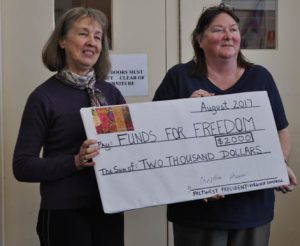
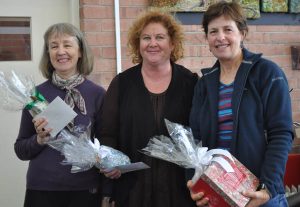
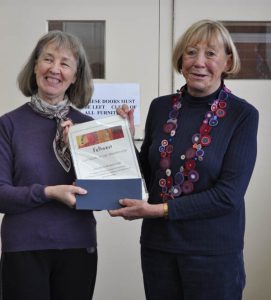

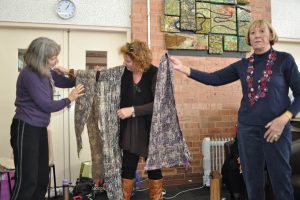
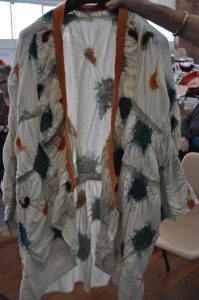 the process regarding shrinkage, preparation of the prefelt and fit of the garment. The jacket was in an abstract pattern of shades of green and peach/orange on the cream muslin.
the process regarding shrinkage, preparation of the prefelt and fit of the garment. The jacket was in an abstract pattern of shades of green and peach/orange on the cream muslin.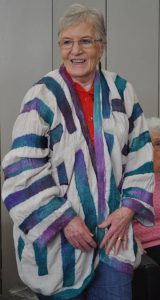

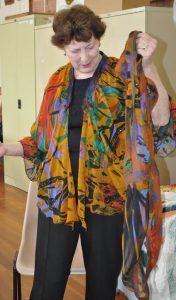
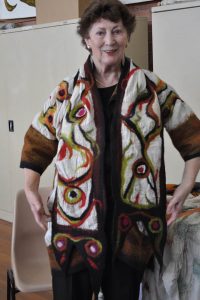
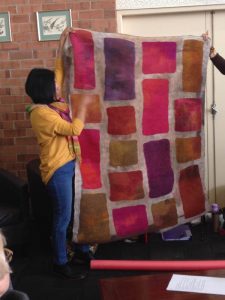
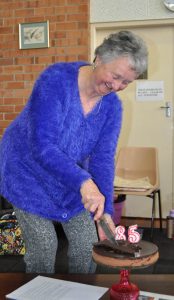
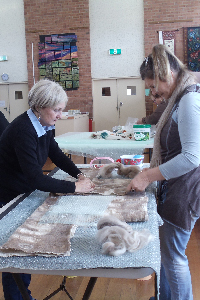
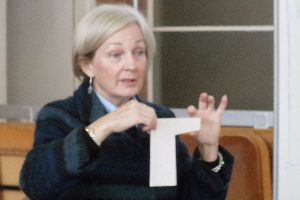 Marvellous Muslin Jacket with Jan Manning August 2017
Marvellous Muslin Jacket with Jan Manning August 2017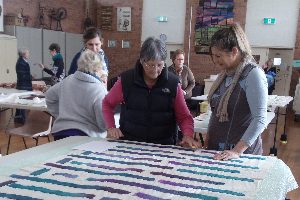

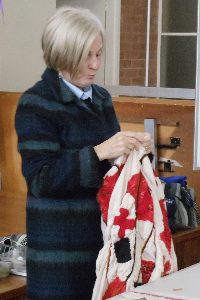
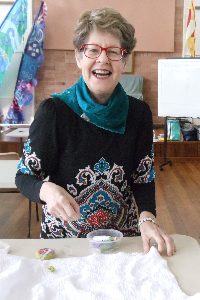
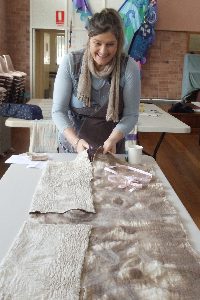
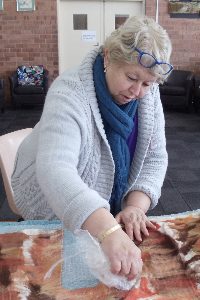
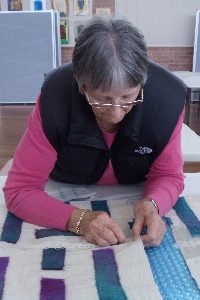
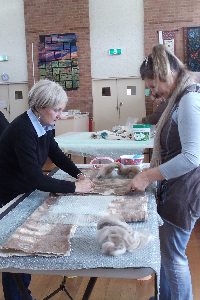
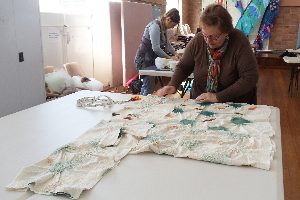
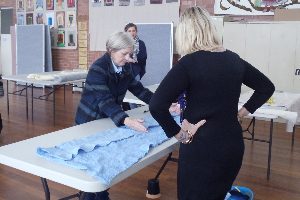
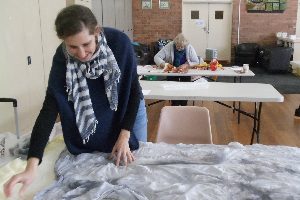

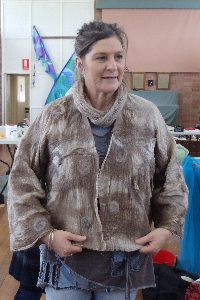


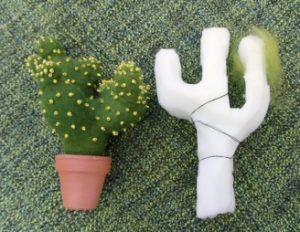

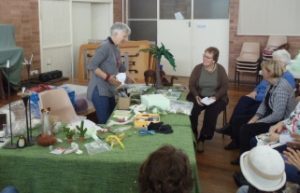
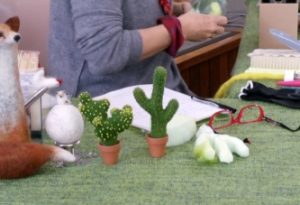
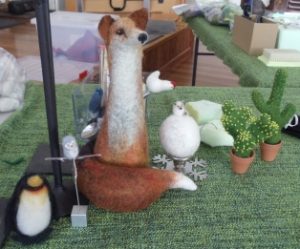

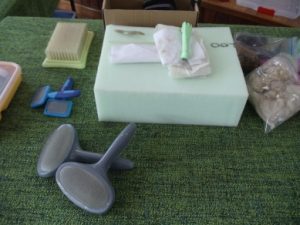
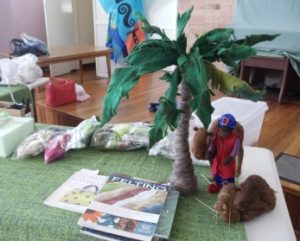

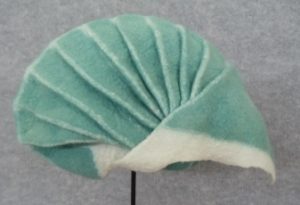


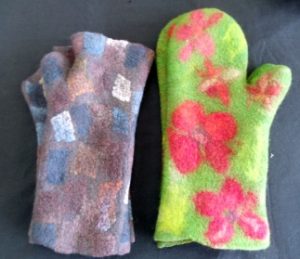

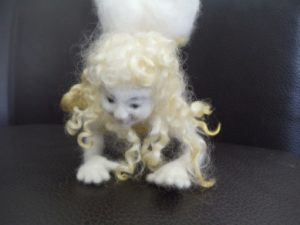
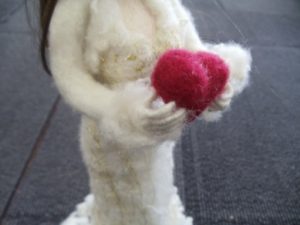





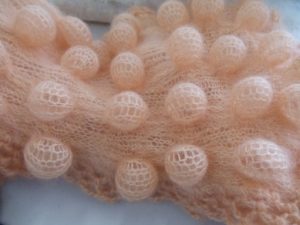




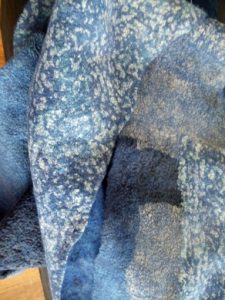
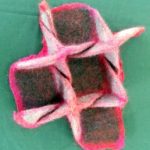
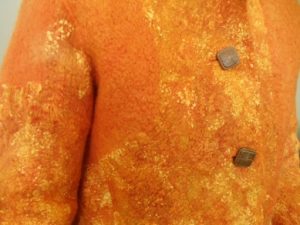




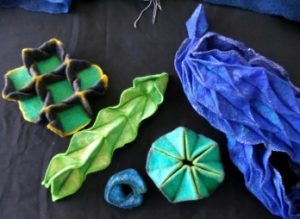

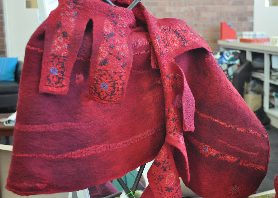
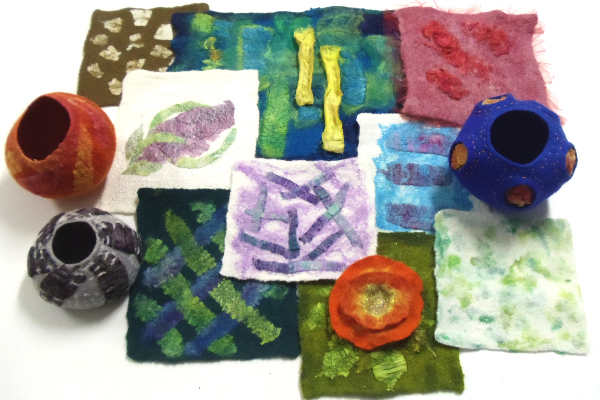
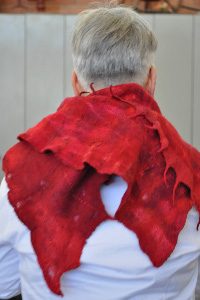
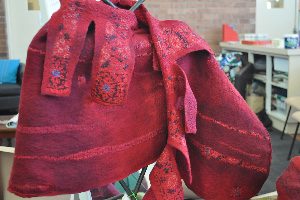 Kerry Bertucci wore a fine red shawl that she made with merino wool and drafted silk. She also displayed a shawl/wrap in shades of red that she had designed by 1st drawing her pattern on an old discarded blanket to ensure that she got the correct drape that she wanted. She then enlarged the pattern according to the expected shrinkage. The end result was a reversible garment made of wool and silk fabric.
Kerry Bertucci wore a fine red shawl that she made with merino wool and drafted silk. She also displayed a shawl/wrap in shades of red that she had designed by 1st drawing her pattern on an old discarded blanket to ensure that she got the correct drape that she wanted. She then enlarged the pattern according to the expected shrinkage. The end result was a reversible garment made of wool and silk fabric.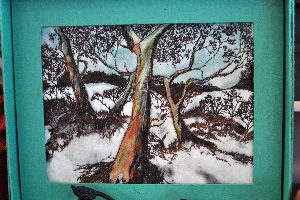 Vimol showed us 2 beautiful framed pictures. “The gum tree” was done with needle felting on a wool blanket and machine embroidery. “The Pom Pom tree” was done with wet felting and then hand embroidered. Her work was finely executed and most attractive.
Vimol showed us 2 beautiful framed pictures. “The gum tree” was done with needle felting on a wool blanket and machine embroidery. “The Pom Pom tree” was done with wet felting and then hand embroidered. Her work was finely executed and most attractive.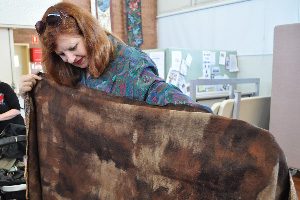 Kerry Grove showed us all the items that she completed at our recent Retreat weekend. She made samples, a phone bag and cord, a sari silk runner and a beautiful shawl. She certainly was busy at the Retreat!
Kerry Grove showed us all the items that she completed at our recent Retreat weekend. She made samples, a phone bag and cord, a sari silk runner and a beautiful shawl. She certainly was busy at the Retreat!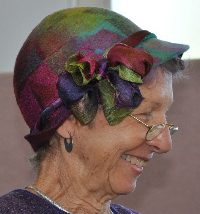
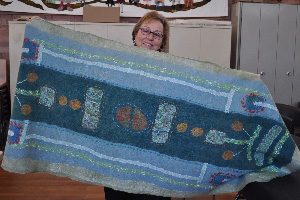
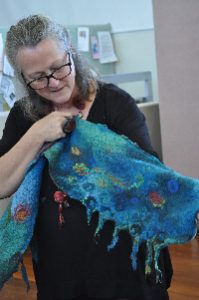

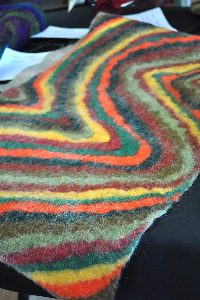
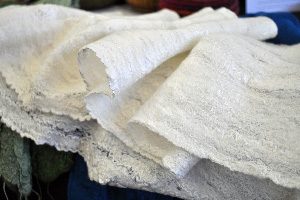
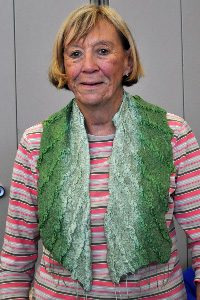
 Liz Odd showed us 2 silk and wool scarves/collars that were made using masking tape as a resist in order to curve the fabric to fit correctly around the neck.
Liz Odd showed us 2 silk and wool scarves/collars that were made using masking tape as a resist in order to curve the fabric to fit correctly around the neck.
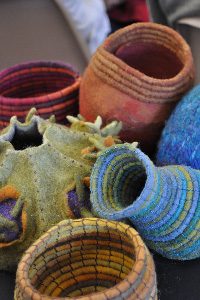
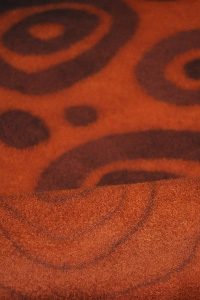
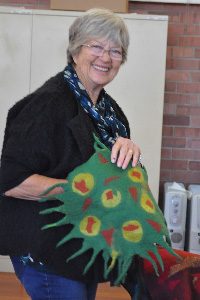 Alison Gomes made a fine merino wool scarf in an autumn rust colour. She applied black wool prefelts to the one side and discovered that the edges were drawn through the rust and created a lovely black line on the reverse side.
Alison Gomes made a fine merino wool scarf in an autumn rust colour. She applied black wool prefelts to the one side and discovered that the edges were drawn through the rust and created a lovely black line on the reverse side. Marie M made a stunning Opal coloured wrap at the Retreat using silk lap and wool. Because she was concerned that the colours were too bright she used black wool which toned down the colours. The colours ran and stained her hands. Very helpful to have made a sample before. Luckily she was using black wool so disaster was averted!
Marie M made a stunning Opal coloured wrap at the Retreat using silk lap and wool. Because she was concerned that the colours were too bright she used black wool which toned down the colours. The colours ran and stained her hands. Very helpful to have made a sample before. Luckily she was using black wool so disaster was averted!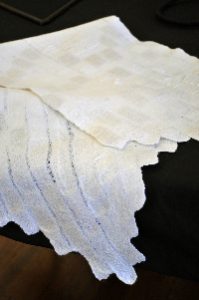

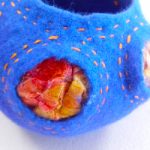
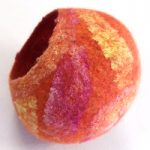
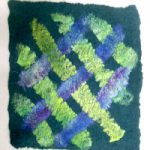
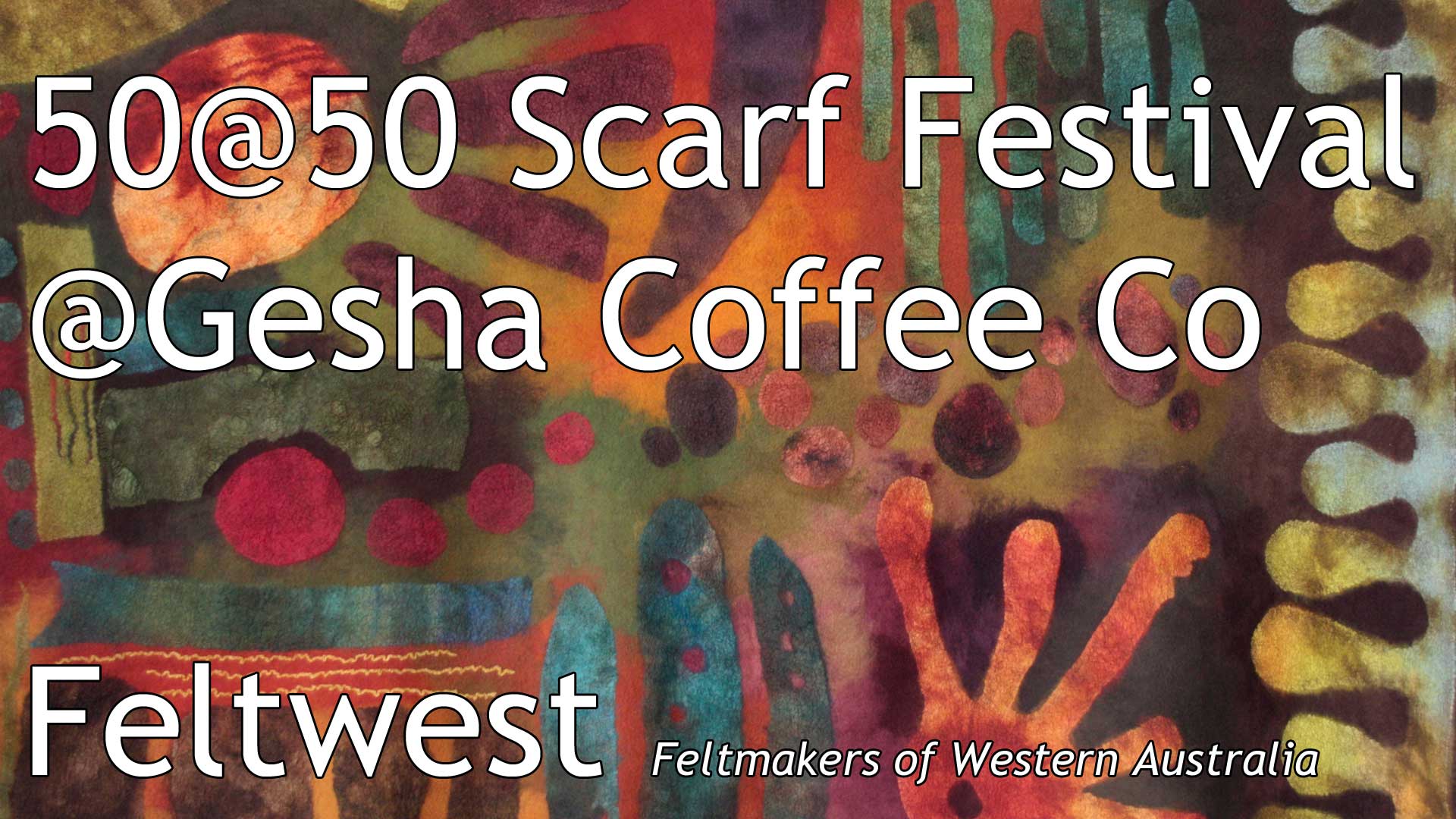
 r Freedom Project that the proceeds of the scarf project will be donated to.
r Freedom Project that the proceeds of the scarf project will be donated to.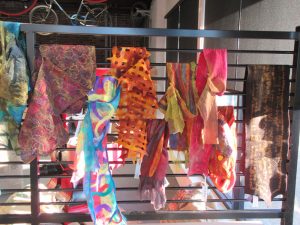 rf sales got off to a roaring start with over 20 scarves being sold on the morning. More scarves were donated as the month progressed and we reached our target of 50 scarves, making a beautiful display. By the end of the end of the month, we had raised $2,000. Well done everyone.
rf sales got off to a roaring start with over 20 scarves being sold on the morning. More scarves were donated as the month progressed and we reached our target of 50 scarves, making a beautiful display. By the end of the end of the month, we had raised $2,000. Well done everyone.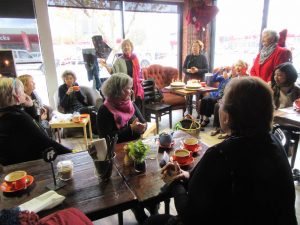

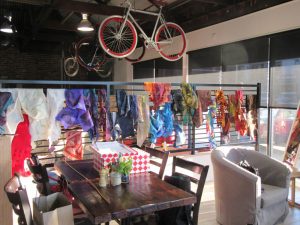

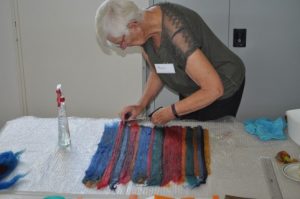
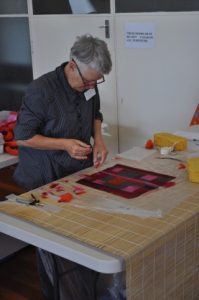

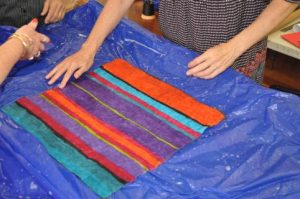

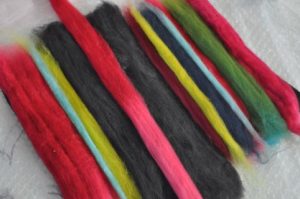
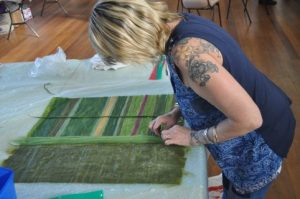

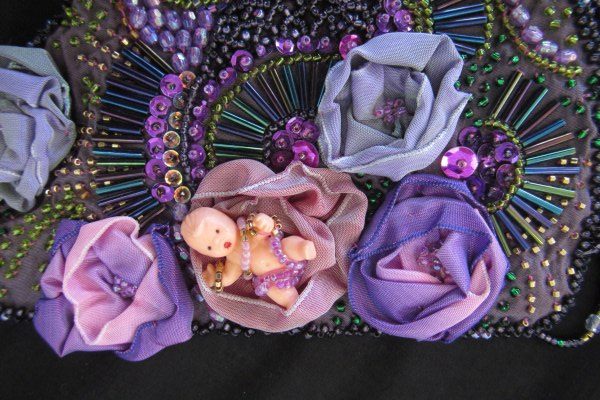
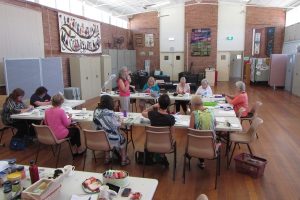
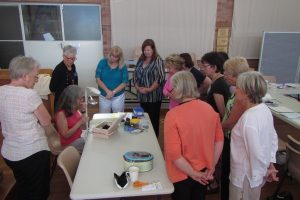
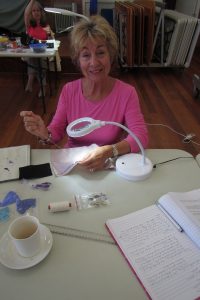
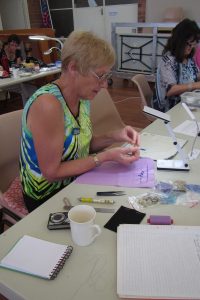
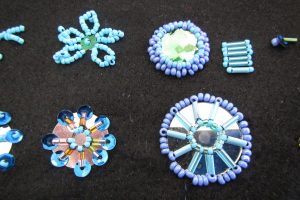
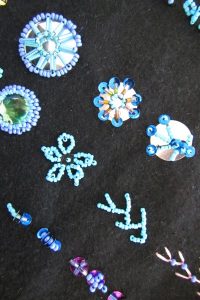
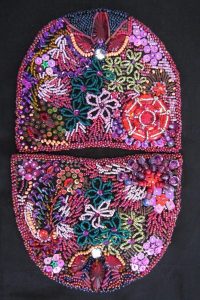
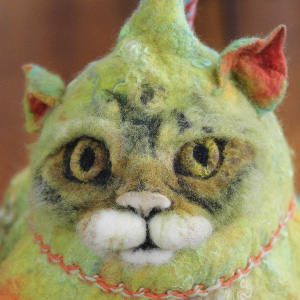
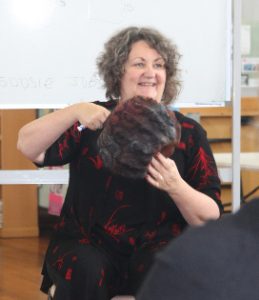
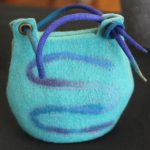
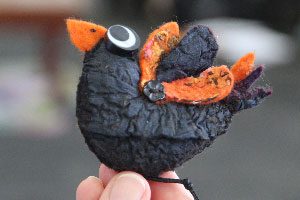 Toss n Tell
Toss n Tell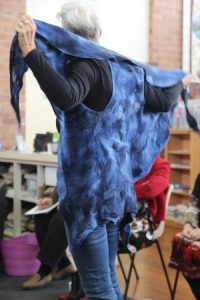
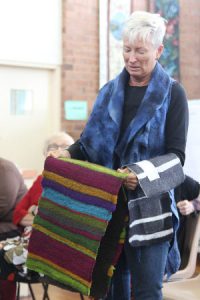
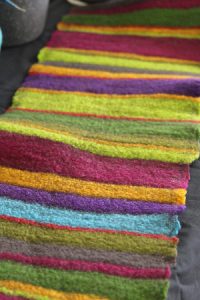
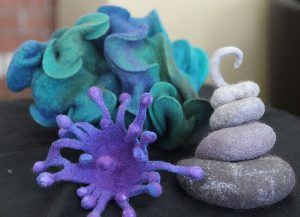
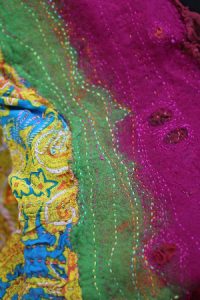
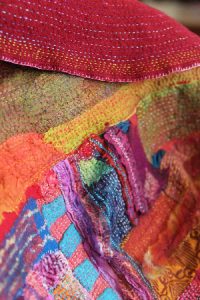
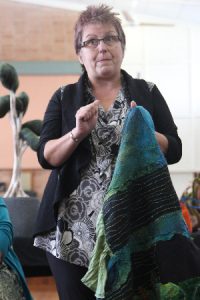
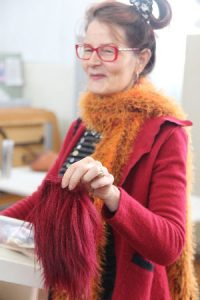
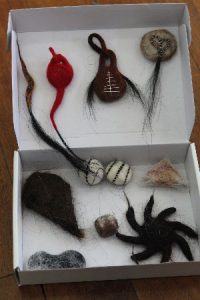
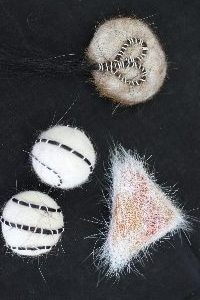
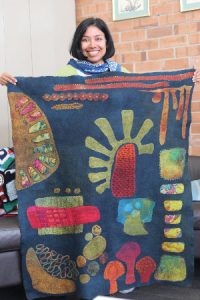
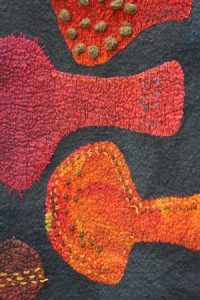 Alison showed her latest project that she has just completed. She explained her procedure of work from concept to execution. Her colours and design are quite unique and admired by those present. Although it is a large wall hanging she only used 250g wool for this project.
Alison showed her latest project that she has just completed. She explained her procedure of work from concept to execution. Her colours and design are quite unique and admired by those present. Although it is a large wall hanging she only used 250g wool for this project.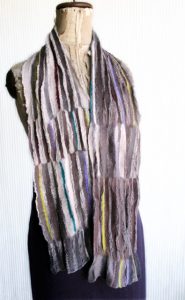 from Soosie’s online workshop.
from Soosie’s online workshop.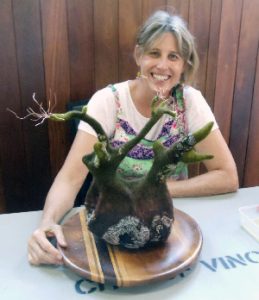 Nancy showed her blue striped nuno scarf using silk mesh as well as a fine striped one in neutral shades which she used when teaching her Stripe Sequencing workshop.
Nancy showed her blue striped nuno scarf using silk mesh as well as a fine striped one in neutral shades which she used when teaching her Stripe Sequencing workshop.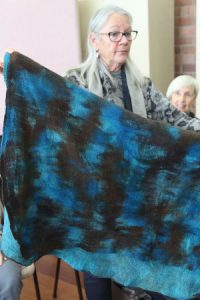 Susan Sheppard ( visitor) had made a lovely wrap in blue and brown.
Susan Sheppard ( visitor) had made a lovely wrap in blue and brown.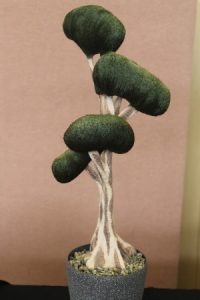 Sue Swain showed us a very sculptural piece of sea sponge that she found on the beach.
Sue Swain showed us a very sculptural piece of sea sponge that she found on the beach.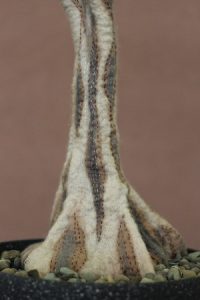
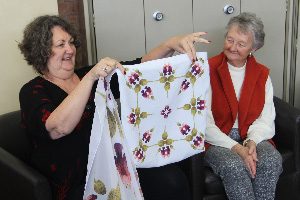 She accessed a website : Redbubble.com that will print any designs you submit. She printed her “synchronised fish” design onto a bag, a scarf and another design onto her mobile phone cover.
She accessed a website : Redbubble.com that will print any designs you submit. She printed her “synchronised fish” design onto a bag, a scarf and another design onto her mobile phone cover.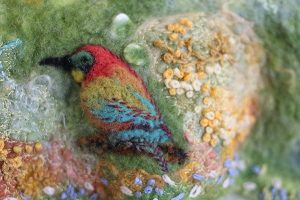 Vimol used a combination of wet felting, needle felting and embroidery to make 2 wonderful, whimsical hats, 1 with a face of a cat in relief. She also needle felted a head with a face in relief for a hat to be displayed on.
Vimol used a combination of wet felting, needle felting and embroidery to make 2 wonderful, whimsical hats, 1 with a face of a cat in relief. She also needle felted a head with a face in relief for a hat to be displayed on.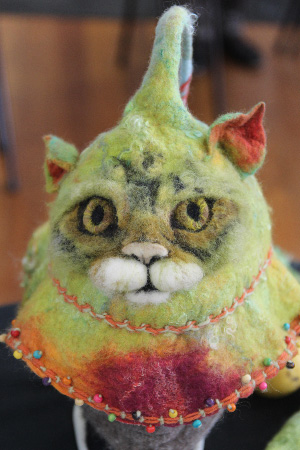
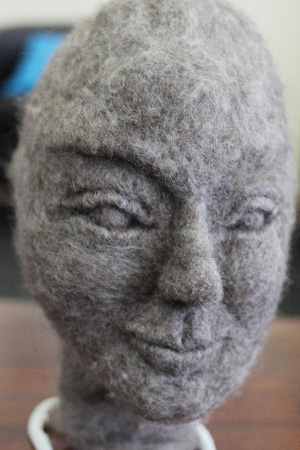
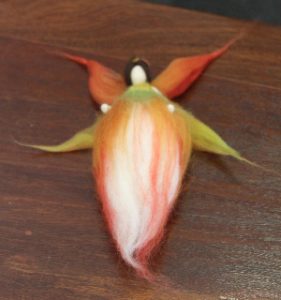
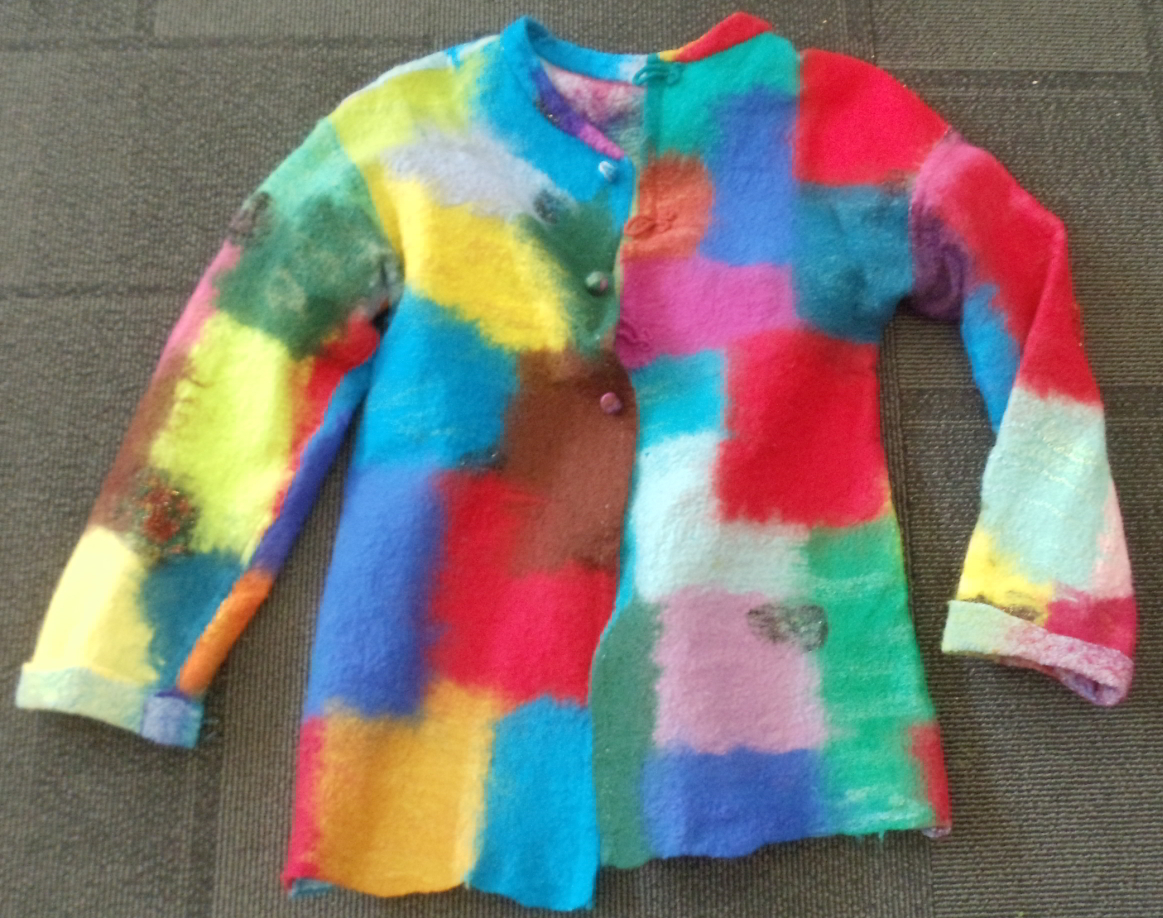

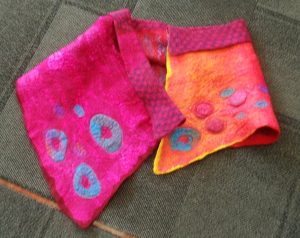
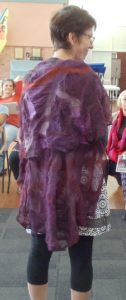
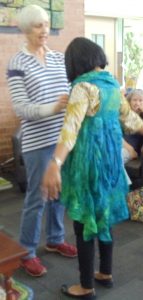
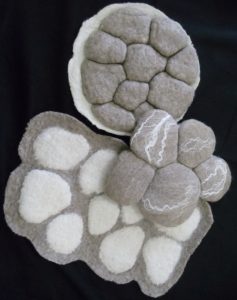
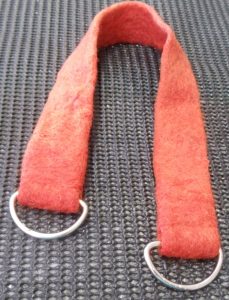
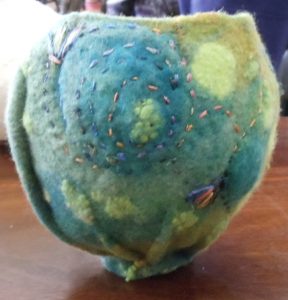
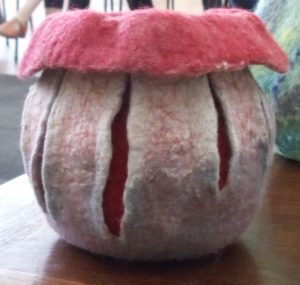
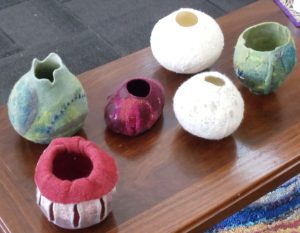
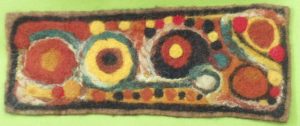
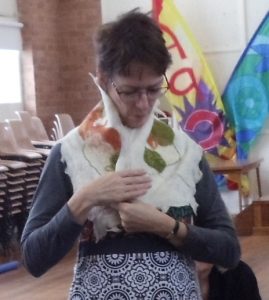
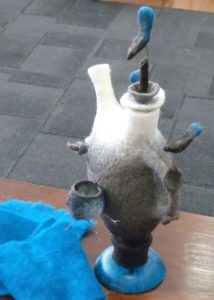 Kerry had attended the Pam McGregor workshop and showed her finished teapot that had delightful little birds nesting on the branches of the “treepot”.
Kerry had attended the Pam McGregor workshop and showed her finished teapot that had delightful little birds nesting on the branches of the “treepot”.